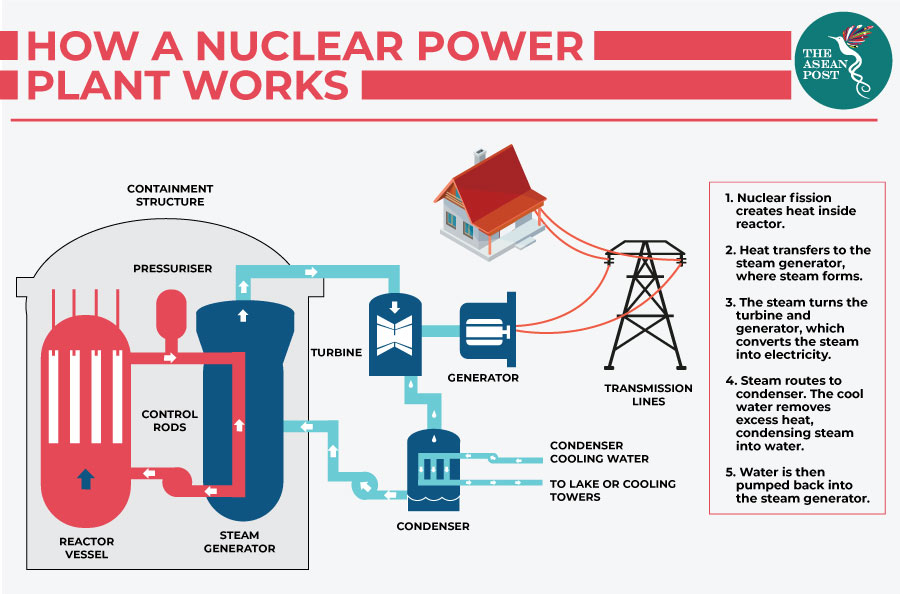Nuclear energy might be coming to the Philippines soon after an International Atomic Energy Agency (IAEA) team of experts concluded an eight-day mission in December to review the country's infrastructure development for nuclear power.
The Integrated Nuclear Infrastructure Review (INIR) was conducted at the Bataan Nuclear Power Plant after an invitation by the Philippines government. Currently, the Philippines is the only country in ASEAN with a completed nuclear power plant.
Philippines’ Energy Secretary Alfonso Cusi said the Philippines is "openly considering" the feasibility of introducing nuclear power as a means of addressing its energy security and energy equity. With a fast-growing economy, the Philippines’ demand for energy is expected to triple by 2040.
The IAEA noted that the Philippines is following a systematic approach to finalise its nuclear power strategy and complete the associated infrastructure development. Cusi said results from the INIR mission will help the Philippines focus its efforts on the identified gaps, accelerate the legislative process and prepare the national decision.
“It is high time we put the framework in place to bring nuclear power into the energy mix. We should learn the lessons from the past and catch up with the missed opportunities,” Cusi was quoted as saying on the IAEA website.
Pioneering Philippines
The country’s existing nuclear power plant in Morong, a town in the Bataan province, is one of 13 potential sites spread out across the country. The power plant was completed 30 years ago under the Marcos regime in response to the 1973 oil crisis but was never operational.
The power plant cost the Philippines US$2.3 billion and was expected to generate 621 megawatts (MW) of power, but after President Marcos was overthrown in 1986 and the Chernobyl disaster happened a few months later, newly-elected president Corazon Aquino decided not to operate the plant. Today, the Bataan plant has become a tourist attraction and is visited by about 6,000 students and guests yearly.
Russia has been urging the Philippines’ government to restart the facility, and experts from the Rosatom State Atomic Energy Corporation made a discreet visit to Bataan in 2017 to inspect the nuclear facility. The Russian experts reported that the Bataan plant can become operational but would require repairs costing between US$3 billion to US$4 billion.
Filipino president Rodrigo Duterte is also thinking of making the Bataan plant operational and has said that safety will be his top priority in deciding whether to go forward with the plan. In 2016, Duterte ordered a study on the possibility of reopening the powerplant, and while not part of his massive “Build, Build, Build” infrastructure program, nuclear energy could be important in fuelling his infrastructure projects. Furthermore, Duterte could be eyeing nuclear energy as an option to feed the growing energy demands of the Philippines.

Russia’s interest in Bataan is probably economic. Nuclear energy is one of its biggest economic assets. Russia exports goods and services pertaining to nuclear energy all over the world. At the moment, they have over 20 nuclear power reactors confirmed or planned for export construction. According to the World Nuclear Association, foreign orders totalled US$133 billion at the end of 2016.
In 2016, Vladimir Putin himself personally urged ASEAN to look into nuclear energy.
"Moscow is ready to cover the market and is ready to offer member countries projects on the construction of next generation nuclear electrical power stations,” Putin said at the Russia-ASEAN summit in Sochi.
Nuclear energy in Asia however, has been contentious to say the least. Ever since the Fukushima disaster in 2011, gaining popular support for nuclear projects has been difficult. In 2016, Vietnam decided to scrap its nuclear power plant plans with Russia and Japan after decades of nuclear-preparations citing rising costs and safety concerns.
Among the biggest safety concerns when it comes to nuclear power plants are accidents. While the Nuclear Energy Institute highlights that nuclear energy does not produce any greenhouse gasses and is the largest clean-air energy source, the reality is that a nuclear accident can cause irreversible long-term environmental damage as seen in Fukushima and Chernobyl. The amount of damage that a potential nuclear accident could cause heavily outweighs the benefits of nuclear energy.
It is not known at this point whether the Bataan plant will be activated. The Philippines government might have a difficult task of convincing its people that a nuclear plant is needed in the country. Historically, the Philippines has always had a strong anti-nuclear sentiment. There were large demonstrations and public protests when the Bataan power plant was under construction in the 70s and 80s. We could see a resurgence of that if plans to reopen the power plant go ahead.
This article was first published on 25 December, 2019.
Related articles:
Can Duterte’s “Build! Build! Build!” boost the Philippines’ economy?
